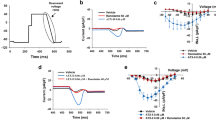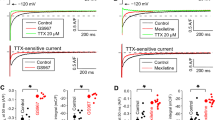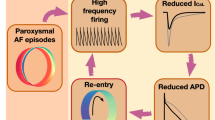Abstract
Eleutheroside B (EB) is the main active constituent derived from the Chinese herb Acanthopanax senticosus (AS) that has been reported to possess cardioprotective effects. In this study we investigated the effects of EB on cardiac electrophysiology and its suppression on atrial fibrillation (AF). Whole-cell recording was conducted in isolated rabbit atrial myocytes. The intracellular calcium ([Ca2+]i) concentration was measured using calcium indicator Fura-2/AM fluorescence. Monophasic action potential (MAP) and electrocardiogram (ECG) synchronous recordings were conducted in Langendorff-perfused rabbit hearts using ECG signal sampling and analysis system. We showed that EB dose-dependently inhibited late sodium current (INaL), transient sodium current (INaT), and sea anemone toxin II (ATX II)-increased INaL with IC50 values of 167, 1582, and 181 μM, respectively. On the other hand, EB (800 μM) did not affect L-type calcium current (ICaL), inward rectifier potassium channel current (IK), and action potential duration (APD). Furthermore, EB (300 μM) markedly decreased ATX II-prolonged the APD at 90% repolarization (APD90) and eliminated ATX II-induced early afterdepolarizations (EADs), delayed afterdepolarizations (DADs), and triggered activities (TAs). Moreover, EB (200 μM) significantly suppressed ATX II-induced Na+-dependent [Ca2+]i overload in atrial myocytes. In the Langendorff-perfused rabbit hearts, application of EB (200 μM) or TTX (2 μM) substantially decreased ATX II-induced incidences of atrial fibrillation (AF), ventricular fibrillation (VF), and heart death. These results suggest that augmented INaL alone is sufficient to induce AF, and EB exerts anti-AF actions mainly via blocking INaL, which put forward the basis of pharmacology for new clinical application of EB.
Similar content being viewed by others
Log in or create a free account to read this content
Gain free access to this article, as well as selected content from this journal and more on nature.com
or
References
Jin X, Jiang Y, Xue G, Yuan Y, Zhu H, Zhan L, et al. Increase of late sodium current contributes to enhanced susceptibility to atrial fibrillation in diabetic mice. Eur J Pharmacol. 2019;857:172444.
Yadava M, Hughey AB, Crawford TC. Postoperative atrial fibrillation: incidence, mechanisms, and clinical correlates. Heart Fail Clin. 2016;12:299–308.
Huang L, Zhao H, Huang B, Zheng C, Peng W, Qin L. Acanthopanax senticosus: review of botany, chemistry and pharmacology. Pharmazie. 2011;66:83–97.
Li C, Wang X, Hu X, Fang H, Qiao S. Determination of eleutheroside B in antifatigue fraction of Acanthopanax senticosus by HPLC. Zhongguo Zhong Yao Za Zhi. 2008;33:2800–2.
Lee CH, Huang CW, Chang PC, Shiau JP, Lin IP, Lin MY, et al. Reactive oxygen species mediate the chemopreventive effects of syringin in breast cancer cells. Phytomedicine. 2019;61:152844.
Cho JY, Nam KH, Kim AR, Park J, Yoo ES, Baik KU, et al. In-vitro and in-vivo immunomodulatory effects of syringin. J Pharm Pharmacol. 2001;53:1287–94.
Zhou Y, Cheng C, Baranenko D, Wang J, Li Y, Lu W. Effects of Acanthopanax senticosus on brain injury induced by simulated spatial radiation in mouse model based on pharmacokinetics and comparative proteomics. Int J Mol Sci. 2018;19:159.
Kim B, Kim MS, Hyun CK. Syringin attenuates insulin resistance via adiponectin-mediated suppression of low-grade chronic inflammation and ER stress in high-fat diet-fed mice. Biochem Biophys Res Commun. 2017;488:40–5.
Liu KY, Wu YC, Liu IM, Yu WC, Cheng JT. Release of acetylcholine by syringin, an active principle of Eleutherococcus senticosus, to raise insulin secretion in Wistar rats. Neurosci Lett. 2008;434:195–9.
Lau KM, Yue GG, Chan YY, Kwok HF, Gao S, Wong CW, et al. A review on the immunomodulatory activity of Acanthopanax senticosus and its active components. Chin Med. 2019;14:25.
Bai Y, Tohda C, Zhu S, Hattori M, Komatsu K. Active components from Siberian ginseng (Eleutherococcus senticosus) for protection of amyloid beta(25-35)-induced neuritic atrophy in cultured rat cortical neurons. J Nat Med. 2011;65:417–23.
Tohda C, Ichimura M, Bai Y, Tanaka K, Zhu S, Komatsu K. Inhibitory effects of Eleutherococcus senticosus extracts on amyloid beta(25-35)-induced neuritic atrophy and synaptic loss. J Pharmacol Sci. 2008;107:329–39.
Li F, Zhang N, Wu Q, Yuan Y, Yang Z, Zhou M, et al. Syringin prevents cardiac hypertrophy induced by pressure overload through the attenuation of autophagy. Int J Mol Med. 2017;39:199–207.
Liang Q, Yu X, Qu S, Xu H, Sui D. Acanthopanax senticosides B ameliorates oxidative damage induced by hydrogen peroxide in cultured neonatal rat cardiomyocytes. Eur J Pharmacol. 2010;627:209–15.
Sui D, Qu S, Yu X, Chen Y, Ma X. Protective effect of ASS on myocardial ischemia-reperfusion injury in rats. Zhongguo Zhong Yao Za Zhi. 2004;29:71–4.
Guo S, Liu Y, Lin Z, Tai S, Yin S, Liu G. Effects of eleutheroside B and eleutheroside E on activity of cytochrome P450 in rat liver microsomes. BMC Complement Altern Med. 2014;14:1.
Makielski JC. Late sodium current: a mechanism for angina, heart failure, and arrhythmia. Trends Cardiovasc Med. 2016;26:115–22.
Saint DA. The role of the persistent Na+ current during cardiac ischemia and hypoxia. J Cardiovasc Electrophysiol. 2006;17:S96–S103.
Xie LH, Chen F, Karagueuzian HS, Weiss JN. Oxidative-stress-induced afterdepolarizations and calmodulin kinase II signaling. Circ Res. 2009;104:79–86.
Guo D, Yu M, Liu Q, Cox RH, Liu T, Yan GX. Ventricular hypertrophy amplifies transmural dispersion of repolarization by preferentially increasing the late sodium current in endocardium. J Electrocardiol. 2014;47:642–8.
Valdivia CR, Chu WW, Pu J, Foell JD, Haworth RA, Wolff MR, et al. Increased late sodium current in myocytes from a canine heart failure model and from failing human heart. J Mol Cell Cardiol. 2005;38:475–83.
Blana A, Kaese S, Fortmuller L, Laakmann S, Damke D, van Bragt K, et al. Knock-in gain-of-function sodium channel mutation prolongs atrial action potentials and alters atrial vulnerability. Heart Rhythm. 2010;7:1862–9.
Tang Q, Ma J, Zhang P, Wan W, Kong L, Wu L. Persistent sodium current and Na+/H+ exchange contributes to the augmentation of the reverse Na+/Ca2+ exchange during hypoxia or acute ischemia in ventricular myocytes. Pflugers Arch. 2012;463:513–22.
Heijman J, Ghezelbash S, Dobrev D. Investigational antiarrhythmic agents: promising drugs in early clinical development. Expert Opin Investig Drugs. 2017;26:897–907.
Poulet C, Wettwer E, Grunnet M, Jespersen T, Fabritz L, Matschke K, et al. Late sodium current in human atrial cardiomyocytes from patients in sinus rhythm and atrial fibrillation. PLoS One. 2015;10:e0131432.
Guo D, Jenkinson S. Simultaneous assessment of compound activity on cardiac Nav1.5 peak and late currents in an automated patch clamp platform. J Pharmacol Toxicol Methods. 2018;99:106575.
Antzelevitch C, Burashnikov A, Sicouri S, Belardinelli L. Electrophysiologic basis for the antiarrhythmic actions of ranolazine. Heart Rhythm. 2011;8:1281–90.
Gong M, Zhang Z, Fragakis N, Korantzopoulos P, Letsas KP, Li G, et al. Role of ranolazine in the prevention and treatment of atrial fibrillation: a meta-analysis of randomized clinical trials. Heart Rhythm. 2017;14:3–11.
Song Y, Shryock JC, Belardinelli L. An increase of late sodium current induces delayed afterdepolarizations and sustained triggered activity in atrial myocytes. Am J Physiol Heart Circ Physiol. 2008;294:H2031–9.
Song Y, Shryock JC, Belardinelli L. A slowly inactivating sodium current contributes to spontaneous diastolic depolarization of atrial myocytes. Am J Physiol Heart Circ Physiol. 2009;297:H1254–62.
Van Nieuwenhuyse E, Seemann G, Panfilov AV, Vandersickel N. Effects of early afterdepolarizations on excitation patterns in an accurate model of the human ventricles. PLoS One. 2017;12:e0188867.
Wit AL. Afterdepolarizations and triggered activity as a mechanism for clinical arrhythmias. Pacing Clin Electrophysiol. 2018;41:883–96.
Zhang X, Ai X, Nakayama H, Chen B, Harris DM, Tang M, et al. Persistent increases in Ca2+ influx through Cav1.2 shortens action potential and causes Ca2+ overload-induced afterdepolarizations and arrhythmias. Basic Res Cardiol. 2016;111:4.
Nattel S, Dobrev D. The multidimensional role of calcium in atrial fibrillation pathophysiology: mechanistic insights and therapeutic opportunities. Eur Heart J. 2012;33:1870–7.
Pamukcu B, Lane DA, Lip GY. The assessment of stroke and bleeding risk in atrial fibrillation: where are we now? Expert Rev Cardiovasc Ther. 2010;8:1703–10.
Saint DA. The cardiac persistent sodium current: an appealing therapeutic target? Br J Pharmacol. 2008;153:1133–42.
Michniewicz E, Mlodawska E, Lopatowska P, Tomaszuk-Kazberuk A, Malyszko J. Patients with atrial fibrillation and coronary artery disease—double trouble. Adv Med Sci. 2018;63:30–5.
Morita N, Sovari AA, Xie Y, Fishbein MC, Mandel WJ, Garfinkel A, et al. Increased susceptibility of aged hearts to ventricular fibrillation during oxidative stress. Am J Physiol Heart Circ Physiol. 2009;297:H1594–605.
Jiang W, Zeng M, Cao Z, Liu Z, Hao J, Zhang P, et al. Icariin, a novel blocker of sodium and calcium channels, eliminates early and delayed afterdepolarizations, as well as triggered activity, in rabbit cardiomyocytes. Front Physiol. 2017;8:342.
Zeng M, Jiang W, Tian Y, Hao J, Cao Z, Liu Z, et al. Andrographolide inhibits arrhythmias and is cardioprotective in rabbits. Oncotarget. 2017;8:61226–38.
Gong X, Zhang L, Jiang R, Wang C, Yin X, Wan J. Hepatoprotective effects of syringin on fulminant hepatic failure induced by D-galactosamine and lipopolysaccharide in mice. J Appl Toxicol. 2014;34:265–71.
Zang H, Yang Q, Li J. Eleutheroside B protects against acute kidney injury by activating IGF pathway. Molecules. 2019;24:3876.
Ruhsam M, Hollingsworth PM. Authentication of eleutherococcus and rhodiola herbal supplement products in the United Kingdom. J Pharm Biomed Anal. 2018;149:403–9.
Acknowledgements
This research was supported by the National Natural Science Foundation of China (No. 81670302).
Author information
Authors and Affiliations
Contributions
PPZ and JHM contributed to the conception and design of the research. PPZ, ZFG, and PHZ carried out the experiments. PPZ, LS, ZPL, ZFZ, YZJ, and ZZC performed the data acquisition and analyzed the data. PPZ wrote the paper. JHM reviewed and critically revised the paper. All authors reviewed the paper, including the final submitted version.
Corresponding author
Ethics declarations
Competing interests
The authors declare no competing interests.
Rights and permissions
About this article
Cite this article
Zhang, Pp., Guo, Zf., Zhang, Ph. et al. Eleutheroside B, a selective late sodium current inhibitor, suppresses atrial fibrillation induced by sea anemone toxin II in rabbit hearts. Acta Pharmacol Sin 42, 209–217 (2021). https://doi.org/10.1038/s41401-020-0453-z
Received:
Accepted:
Published:
Issue date:
DOI: https://doi.org/10.1038/s41401-020-0453-z
Keywords
This article is cited by
-
Analysis of Eleutherosides by Tandem Mass Spectrometry: Possibilities of Standardizing a Multi-Phytoadaptogen Formulation for Preventive Oncology
Pharmaceutical Chemistry Journal (2022)



